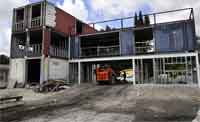| |
|
| |
|
 |
Supply
Chain by the Numbers |
| |
|
| |
- Sept. 27, 2018 -
|
| |
|
| |
|
| |
|
| |
A New Way for Supply Chain to Support Home Building; Money Pouring in to OnLine Freight Start Ups; Amazon Opens Yet another Physical Store Concept; Maersk Completes Arctic Route Test |
| |
|
| |
| |
| |
| |
250,000 |
 |
That's how much it is going to cost a Florida man to build a 3000 square foot home, three-level luxury home – made out of ocean shipping containers. Architect Asghar Fathi says he is using eight cargo containers, which he purchased for $2,500 each, to show the steel boxes could be used to create “sustainable, economical” housing that is very attractive as well. Fathi told a local TV station that the process has so far been a breeze, taking only eight days for the containers to be placed on the lot after the foundation was laid. But there have been issues. Perhaps not surprisingly, the architect says the project requires a talented and meticulous welder, the lack of which has required him to fix some flaws. Still, Fathi wants to see the containers used widely to construct affordable houses. He said he wants to build houses “with a different material so people can have a home without spending millions and millions of dollars.” Sign us up.
|
|
|
| |
| |
|
|
|
That is the minimum “star rating” for products on-line giant Amazon is carrying in a new physical store in New York's SoHo neighborhood. In addition to the minimum star criteria, Amazon says the products must be top sellers, or are new and trending on Amazon's website. The new “Amazon 4-Star” location will include devices, consumer electronics, kitchen wares, home products, toys, books and games. Digital price tags at the store will show both list prices and reduced prices for Prime members. Amazon 4-star opens to the public today, September 27. This new stores adds to the growing portfolio of Amazon physical stores, including the 460 Whole Foods locations, the Amazon Go convenience stores, Amazon Pop-Up kiosks at malls, and Amazon college pick up and return centers. The physical stores may be needed to continue Amazon's rapid growth, though it seems clear most are still in the experimental stage. |
| |
| |
|
| |
| |
| |
10 |
|
That's how many days travel Maersk Line says it saved in a just completed test run moving a container ship from Vladivostok to St. Petersburg using the so-called Northern Sea Route, rather than using than using the normal route through the Suez Canal. The Northern Sea Route (NSR) runs through the Arctic Ocean, mostly north of Russia and then Scandinavia going East to West. The path used to be too ice-covered to be feasible, but warming in recent years has opened the route for longer periods. Some – especially the Russian government – see much promise in the route, but there are still many obstacles. For example, the Venta Maersk vessel used for the test has a capacity of just 3600 TEU, with much larger ships not able to make it through some parts of the route. Such small ships are dramatically less efficient operationally versus the new 20,000 TEU megaships, even if the artic route is much faster. Maersk itself said the trip's goal was to collect data and that it doesn't see it “as an alternative to our usual routes.” However, tankers, operated by Russian state shipping giant Sovcomflot, crossed the NSR more than 100 times this year. |
| |
| |
| |
|
|
|
| |
 |
 |
| |
|
|
| |